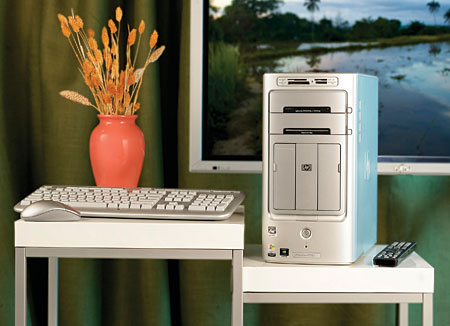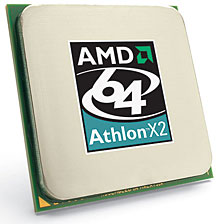HP Pavilion Media Center TV m7580n HTPC
We're down with entertainment PCs here at Home Theater. For those of you who are ready to share the joy, there are basically two ways to join the party. For the hands-on approach, we've written about specific best-of-the-best audio and video cards and other devices that you can plug into your own custom-built box. But, for some readers, personal success has brought with it the notion of luxury. Companies like HP are only too happy to remove the guesswork from the equation and pre-assemble a bundle for you, which you can purchase with one phone call or just a few clicks online. Their Pavilion Media Center TV m7580n HTPC is just such a system.

HP has dubbed the m7580n "TV" for the ease with which it tunes and records television. It works in conjunction with Windows XP Media Center Edition, which incorporates its own free, comprehensive programming guide. The m7580n offers all of the key features of a standalone DVR deck, as well as the benefits of a tricked-out computer. It burns recorded programs to DVD via the DVD+RW/CD-RW drive or converts them to file formats compatible with various portable devices. It's also a respectable gaming rig, with an NVIDIA GeForce 7300 LE card. This midlevel card incorporates a lot of NVIDIA's latest technologies. It's fine for many games, but it's not exactly a screamer. The GeForce 7300 LE also handles all of the MPEG encoding and decoding. The PC comes preloaded with an interesting assortment of entertainment, productivity, and creativity software. Plus, this is a fairly robust PC—it's even compatible with the new Windows Vista operating system—so you can add a whole world of new software. You can also insert additional RAM sticks, swap in newer and higher-end audio/video cards, and add more disk drive space. The possibilities are vast.
 Prime Time
Prime Time
Working with the Windows Media Center interface, the m7580n tells you how to set up your system to work both in your home network and in your home theater. I'm still pretty frustrated by WinMCE's range of available calibration tools, but, hopefully, the next generation will be a little more A/V friendly. HP includes an IR blaster, and you just supply the TV signal—cable, antenna, or even satellite. A USB-connecting emitter is at the end of a generous length of cord that you can place wherever your satellite receiver happens to be. I'm ordinarily not a fan of IR blasters, but, in this case, it offers a great way to bring the dish crowd into the fold. HP also includes a comprehensive CE-style remote control, a cordless keyboard, and a cordless optical mouse. They all performed commendably and had no issues with either battery life or range from the small IR receiver, which is located at the end of its own USB cable. The multimedia keyboard offers an array of quick-access controls for all manner of entertainment. Most notable is a pair of eject keys for two separate optical drives. (The m7580n only comes standard with one drive.)
I discovered my biggest disappointment when I patched the PC into my TV. The m7580n has VGA, composite video, and S-video outputs. So, for most folks, quality will max out at the S-video level, which is less than ideal in the entertainment realm. S-video is actually passable for NTSC cable/satellite content and Internet video, but it doesn't adequately deliver DVD in its proper glory. It also renders smaller PC text (like that on Web pages) extremely difficult to read. Even so, HP doesn't include an S-video cable. (There's no Ethernet cable, either.) There are several audio-hookup options: coaxial digital, 5.1 analog output via a trio of two-channel minijacks (desktop surround style), and a mini headphone jack. Surprisingly, there are no red-and-white RCA-type analog stereo outputs, so you'll also need to pick up a mini-to-RCA-stereo adapter cable.
 All of these ports are located on the rear of the tower, while many more ports are conveniently situated on the face, starting with the card-reader slots. There are two vertical doors, one of which protects the empty bay for optional Personal Media Drives, HP's swappable standalone hard disk drives. The other door conceals a generous collection of audio/video/data inputs. In this regard, the m7580n is meant to play media. It can take ten or more steps to configure some of the audio and video settings, though. Even worse, the manual is not specific to the m7580n. Rather, it's a generic guide to a whole range of products, and it's ultimately up to the user to figure out what's appropriate for this particular computer and what isn't. This is not a WinMCE issue; instead, you'll have to delve into the device menus and submenus.
All of these ports are located on the rear of the tower, while many more ports are conveniently situated on the face, starting with the card-reader slots. There are two vertical doors, one of which protects the empty bay for optional Personal Media Drives, HP's swappable standalone hard disk drives. The other door conceals a generous collection of audio/video/data inputs. In this regard, the m7580n is meant to play media. It can take ten or more steps to configure some of the audio and video settings, though. Even worse, the manual is not specific to the m7580n. Rather, it's a generic guide to a whole range of products, and it's ultimately up to the user to figure out what's appropriate for this particular computer and what isn't. This is not a WinMCE issue; instead, you'll have to delve into the device menus and submenus.
AMD Within
An AMD Athlon 64 X2 4400+ dual-core processor is at the heart of the AMD LIVE!–branded m7580n's varied feats. Although it's rated at a fairly modest 2.2 gigahertz, the evolutions of the distinct processor and platform over the years make it difficult to compare this AMD processor to a similarly spec'd chip from Intel. It does, nonetheless, offer some unique benefits for the entertainment-PC crowd. Among these is the AMD Cool'n'Quiet system-level technology that allows an idling PC to be ready at a moment's notice. The rest of the time, it runs within safe heat parameters with only mildly audible fan noise. Combining its own BIOS with Microsoft's Away Mode driver, the AMD-powered m7580n powers up quickly from hibernate mode after stretches of nonuse. AMD's HyperTransport technology, meanwhile, removes I/O bottlenecks, increases system bandwidth, and reduces those glitches, freezes, and crashes that can ruin the user experience. The integrated DDR memory controller establishes a direct connection between the main memory and the CPU, which increases system speed. This makes the most of the m7580n's 2,048 megabytes of DDR2 SDRAM, which means quicker loading and increased performance, particularly if you're running a graphics-intensive application. AMD's Enhanced Virus Protection is provided, as well.
In addition to all of this, you get the AMD LIVE! Entertainment Suite, which includes a collection of free software downloads, plus entertainment-centric applications and a lot of nifty little tweaks that can make the HTPC odyssey a lot quicker and less stressful. It also shows off what the processor can do, but I guess there's nothing wrong with that. AMD LIVE! Compress is perhaps the best example. It works with WinMCE to transcode audio and video into smaller files, a task that can slow some processors to a virtual crawl. I can attribute much of what impressed me about my time with the m7580n to the CPU: It was quick, capable, and ultimately dependable.
Highlights
• An entertainment-centric PC from HP with lots of clever tweaks
• Powered by a versatile AMD dual-core processor
• User interface and S-video ceiling are a tad frustrating
- Log in or register to post comments




































































